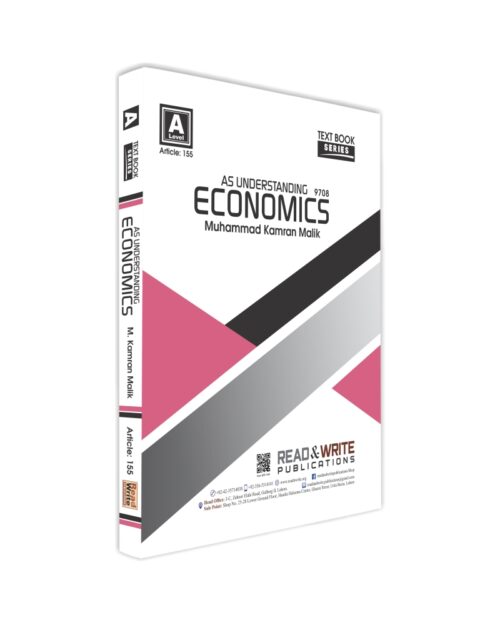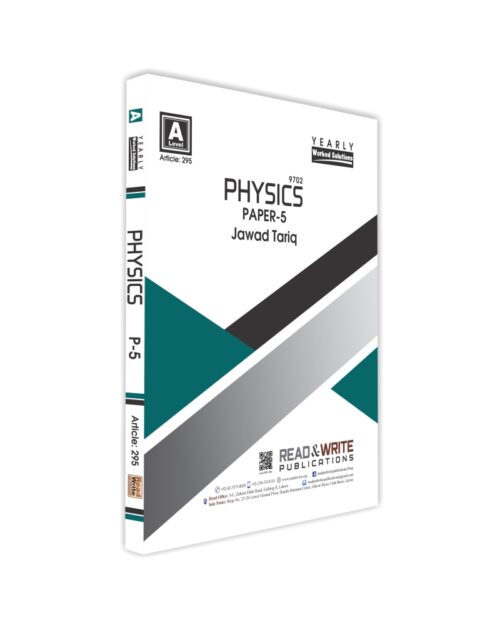| Book Code : | 153 |
|---|---|
| Subject Code : | 9708 |
| Author : | Imran Latif |
| Updated Till : | May/June 2024 |
| Publishers : | Read and Write Publications |
Description
This book provides a thorough exercise of paper 3 for students taking Cambridge International
Examinations Economics A Level Topical Solved Paper. Multiple Choice Questions from past examinations are sorted into relevant chapters and topics which will enable students to practice their understanding systematically.
153 Economics A Level Topical Solved Paper 3
- All variants included
- Answers with detailed explanations
- References of repeated questions included
- Questions order new to old
- According to new Syllabus
TABLE OF CONTENTS
UNIT 1 THEORY OF CONSUMER BEHAVIOR
1.1 (a) LDMU-Meaning
1.1 (b) LDMU-Diagram
1.1 (c) LDMU-Numericals
1.1 (d) LEMU-Meaning
1.1 (e) LEMU-Numericals
1.2 (a) Budget Line
1.2 (b) Indifference curves
1.2 (c) Changes in consumer equilibrium
1.2 (d) Types of goods
1.3 Others
ANSWER SECTION
UNIT 2 PRODUCTION & COST
2.1 (a) LDR-Meaning
2.1 (b) LDR-Diagrams
2.1 (c) LDR-Numericals
2.2 (a) Accounting cost and economic cost
2.2 (b) SR Costs-Meaning and definitions
2.2 (c) SR Costs-Numericals
2.2 (d) SR Costs-Relationship between curves
2.3 Relationship between short-run cost and LDR
2.4 (a) Long run production function
2.4 (b) Least-cost inputs mix
2.4 (c) Isocost and isoquant approach
2.4 (d) Returns to scale
2.5 (a) Internal economies and dis economies of scale
2.5 (b) LRAC and minimum efficient scale
2.6 (a) External economies and dis economies of scale
2.7 Small firms
2.8 (a) Internal growth
2.8 (b) External growth
2.9 Others
ANSWER SECTION
UNIT 3 MARKET STRUCTURE PART 1
3.1 Prince marker behavior and revenue curves
3.2 (a) Profit maximization rule-Diagrams
3.2 (b) Profit maximization rule-Numericals
3.3 Short run prince and output determination
3.4 Long run prince and output determination
3.5 Survival of a firm in short-run and long-run
3.6 Theory of excess capacity
ANSWER SECTION
UNIT 4 MARKET STRUCTURE PART 2
4.1 Features of oligopoly
4.2 Kinked demand curve
4.3 Game theory
4.4 Price collusion
4.5 Determinants of strength of collusion
ANSWER SECTION
UNIT 5 MARKET STRUCTURE PART 3
5.1 (a) Revenue maximization
5.1 (b) Coincidence of profit and revenue maximization
5.1 (c) MC pricing and other government interventions in markets
5.1 (d) Other objectives
5.1 (e) Principle-agent problem
5.2 (a) Price discrimination-Meaning
5.2 (b) Price discrimination-Conditions
5.2 (c) Price discrimination-Consequences
5.3 Barriers to entry and exit
5.4 Comparison of market structures
5.5 Contestable markets
5.6 Advantages and disadvantages of monopoly
5.7 others
ANSWER SECTION
UNIT 6 ECONOMIC EFFICIENCY
6.1 (a) Technical efficiency and X-Efficiency
6.1 (b) Dynamic efficiency
6.2 Allocative efficiency
6.3 PPC and economic efficiency
6.4 Pareto optimality
6.5 Economic efficiency vs equity
ANSWER SECTION
UNIT 7 MARKET FAILURE
7.1 Causes of market failure
ANSWER SECTION
UNIT 8 GOVERNMENT MICROECONOMICS INTERVENTION
8.1 Government policies to correct market failure
8.2 Government failure
8.3 Cost benefit analysis (CBA)
ANSWER SECTION
UNIT 9 LABOUR MARKET
9.1 (a) Supply curve for an individual worker
9.1 (b) The market supply curve for labor
9.1 (c) Marginal cost of labor-Numericals
9.2 MRP Theory
9.3 (a) Wage determination in perfect market-Numericals
9.3 (b) Wage determination in perfect market-Diagrams
9.4 (a) Wage determination in monopsony
9.4 (b) Wage determination with trade union
9.4 (c) Strength of trade union
9.5 Wage differentials
9.6 Transfer earnings and economic rent
9.7 National minimum wage
9.8 Others
ANSWER SECTION
UNIT 10 GLOBALIZATION
10.1 Consequences of formation of trading blocs
10.2 Others
ANSWER SECTION
UNIT 11 BALANCE OF PAYMENTS
ANSWER SECTION
UNIT 12 EXCHANGE RATE
12.1 Trade weighted exchange rate
12.2 Exchange rate systems
12.3 (a) Effects of exchange rate changes
12.3 (b) Marshal learner condition and J curve
ANSWER SECTION
UNIT 13 AGGREGATE EXPENDITURE & MULTIPLIER
13.1 Components of aggregate expenditure
13.2 Changes in marginal and average propensities
13.3 NIE-Numericals
13.4 Inflationary/Deflationary gaps
13.5 (a) Multiplier-Meaning
13.5 (b) Multiplier-Diagrams
13.5 (c) Multiplier-Numericals Level 1
13.5 (d) Multiplier-Numericals Level 2
13.5 (e) Multiplier-Strength
13.6 Accelerator-Meaning
13.7 Others
ANSWER SECTION
UNIT 14 MONEY, BANKING AND INTEREST RATE DETERMINATION
14.1 (a) Features and functions of money
14.1 (b) Money supply
14.2 Types of banks
14.3 Credit creation-process and functions
14.4 Changes in money supply
14.5 Liquidity preference theory (LPT)
14.6 Determination of interest rate
14.7 Quantity theory of money (QTM)
ANSWER SECTION
UNIT 15 EFFECTIVENESS OF MACROECONOMIC POLICIES
15.1 Effectiveness of macroeconomic policies
15.2 Policies to correct current account surplus and defict
15.3 Policies to reduce unemployment
15.4 Policies to encourage economic growth
15.5 The role of automatic stabilisers
15.6 Laffer curve
15.7 Tax systems
15.8 Others
ANSWER SECTION
UNIT 16 MACROECONOMIC OBJECTIVES
16.1 Government economic objectives
16.2 Links between macroeconomic problems and conflicts of aims
16.3 Keynesian and monetarist theoretical approaches
16.4 Others
ANSWER SECTION
UNIT 17 EMPLOYMENT / UNEMPLOYMENT
17.1 Unemployment
ANSWER SECTION
UNIT 18 ECONOMIC GROWTH & SUSTAINABILITY
18.1 Actual and potential growth
18.2 Causes of economic growth
18.3 Costs and benefits of growth
18.4 Inclusive and sustainable growth
18.5 Output gaps
ANSWER SECTION
UNIT 19 INCOME DISTRIBUTION
19.1 (a) Lorenz curve
19.1 (b) Gini coefficients
19.2 policies to redistribute income
Answer Section
UNIT 20 ECONOMIC DEVELOPMENT PART 1
20.1 Living standards
ANSWER SECTION
UNIT 21 ECONOMIC DEVELOPMENT PART 2 (DEVELOPMENT VS DEVELOPED)
21.1 Population structure
21.2 Economic structure
21.3 Kuznets curve
21.4 Poverty trap
21.5 Other difference developing and developed countries
ANSWER SECTION
UNIT 22 ECONOMIC DEVELOPMENT PART 3 (RELATIONSHIP BETWEEN COUNTRIES)
ANSWER SECTION
UNIT 23 UNSORTED
ANSWER SECTION
You must be logged in to post a review.













Reviews
There are no reviews yet.